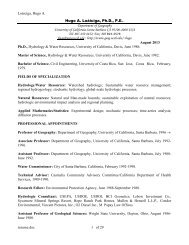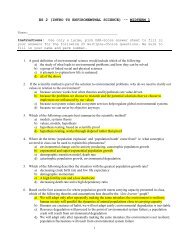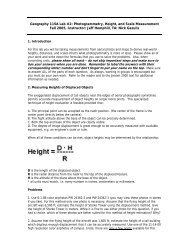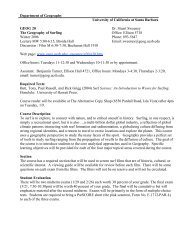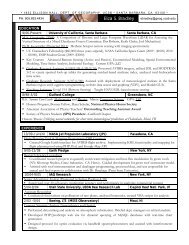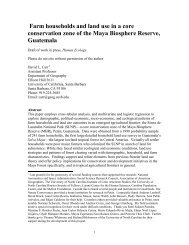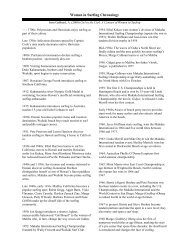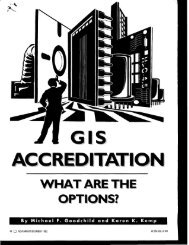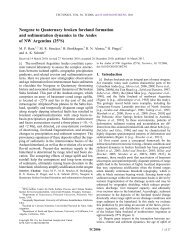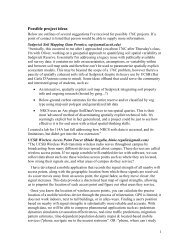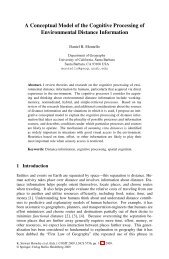Spatial knowledge acquisition from direct experience in the ...
Spatial knowledge acquisition from direct experience in the ...
Spatial knowledge acquisition from direct experience in the ...
Create successful ePaper yourself
Turn your PDF publications into a flip-book with our unique Google optimized e-Paper software.
114 T. Ishikawa, D.R. Montello / Cognitive Psychology 52 (2006) 93–129<br />
Fig. 9. Comparison of <strong>direct</strong>ion estimation by simulations to that by participants. Bars represent mean absolute<br />
errors (+SEs) <strong>in</strong> degrees. For <strong>the</strong> U-route (or <strong>the</strong> S-route), performance by <strong>the</strong> front-back model was worse (or<br />
better), and that by <strong>the</strong> two 90°-turn models was not diVerent (or worse), than participants’ mean performance.<br />
For <strong>the</strong> <strong>in</strong>tegrated routes, performance by <strong>the</strong> left-right model was worse than participants’ performance.<br />
<strong>in</strong>formative. To learn more about <strong>the</strong> sophistication of spatial <strong>knowledge</strong> required to<br />
atta<strong>in</strong> <strong>the</strong> particular levels of performance that we observe <strong>in</strong> our data, we compared performance<br />
by participants after <strong>the</strong> Wrst session to diVerent models of m<strong>in</strong>imal spatial<br />
<strong>knowledge</strong>, by us<strong>in</strong>g a Monte Carlo simulation method. 6 See Table 1 for <strong>the</strong> type of <strong>knowledge</strong><br />
that is possessed by an agent assumed by each simulation model.<br />
4.1. Simulated <strong>direct</strong>ion estimates<br />
Three models for with<strong>in</strong>-route <strong>direct</strong>ion estimates and one model for between-route<br />
<strong>direct</strong>ion estimates (for <strong>the</strong> <strong>in</strong>tegrated routes) were evaluated. Results of <strong>the</strong> simulations<br />
(absolute errors) after 1000 iterations are shown <strong>in</strong> Fig. 9, along with performance by participants<br />
for each route separately and <strong>the</strong> <strong>in</strong>tegrated routes.<br />
4.1.1. Front-back model<br />
This model assumed an agent that knows <strong>the</strong> order of landmarks but not <strong>the</strong>ir distances<br />
apart, regards <strong>the</strong> routes as be<strong>in</strong>g roughly straight, and is able to judge correctly whe<strong>the</strong>r a<br />
target landmark is <strong>in</strong> front of or beh<strong>in</strong>d itself. If a target landmark was <strong>in</strong> front, <strong>the</strong> model<br />
randomly chose a <strong>direct</strong>ion with<strong>in</strong> a 90° cone <strong>in</strong> front (between 315° and 45°, <strong>direct</strong>ions<br />
be<strong>in</strong>g measured clockwise <strong>from</strong> <strong>the</strong> fac<strong>in</strong>g <strong>direct</strong>ion); if a target landmark was <strong>in</strong> back, it<br />
randomly chose a <strong>direct</strong>ion with<strong>in</strong> a 90° cone beh<strong>in</strong>d (between 135° and 225°). 7 For <strong>the</strong> U-<br />
route, simulated performance was worse (i.e., larger absolute error) than performance by<br />
participants, z D 11.07, p < .001; for <strong>the</strong> S-route, simulated performance was better (i.e.,<br />
smaller absolute error), z D¡3.35, p < .001.<br />
6 Comparison to data <strong>from</strong> <strong>the</strong> last session yielded similar results, with some improvements evident over <strong>the</strong><br />
Wrst session. For <strong>the</strong> sake of brevity, we report here only comparison with <strong>the</strong> Wrst session.<br />
7 Because no signiWcant ma<strong>in</strong> eVects or <strong>in</strong>teractions had been found for <strong>the</strong> fac<strong>in</strong>g <strong>direct</strong>ion at each landmark,<br />
we collapsed <strong>the</strong> two conditions with respect to <strong>the</strong> fac<strong>in</strong>g <strong>direct</strong>ion here (as we did with all simulations of <strong>direct</strong>ion<br />
estimates reported below).



